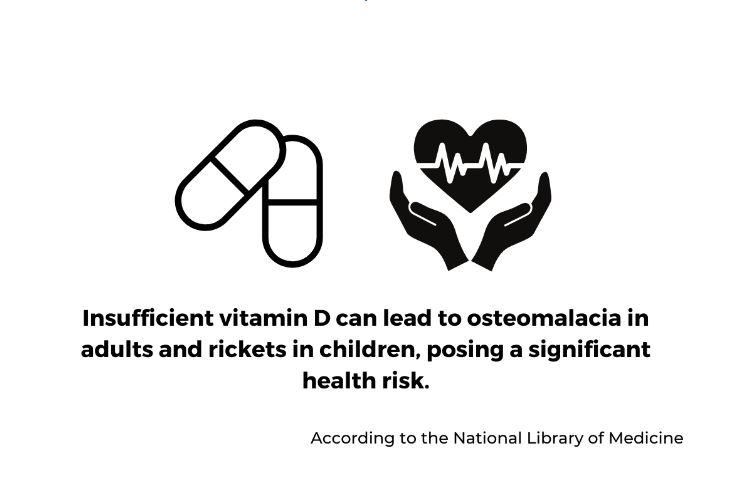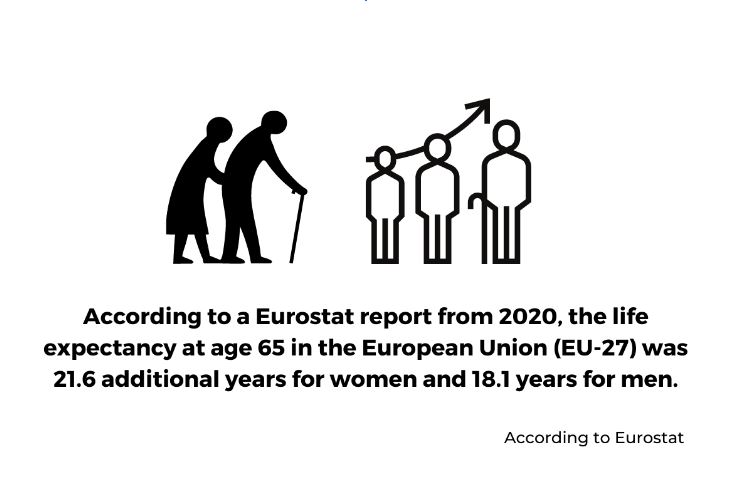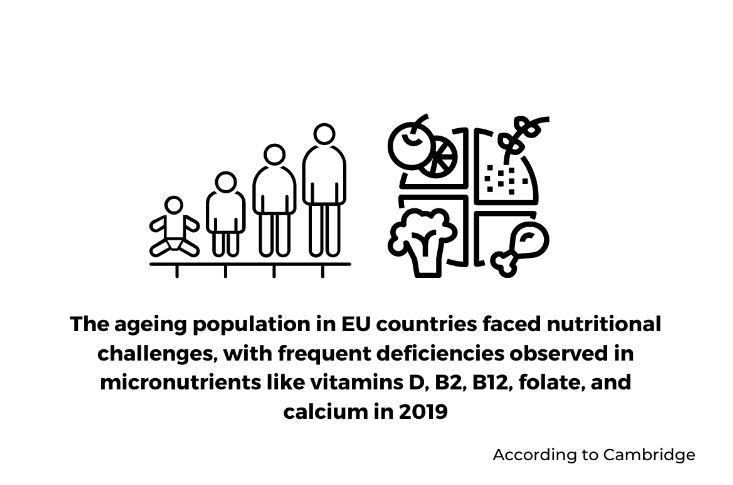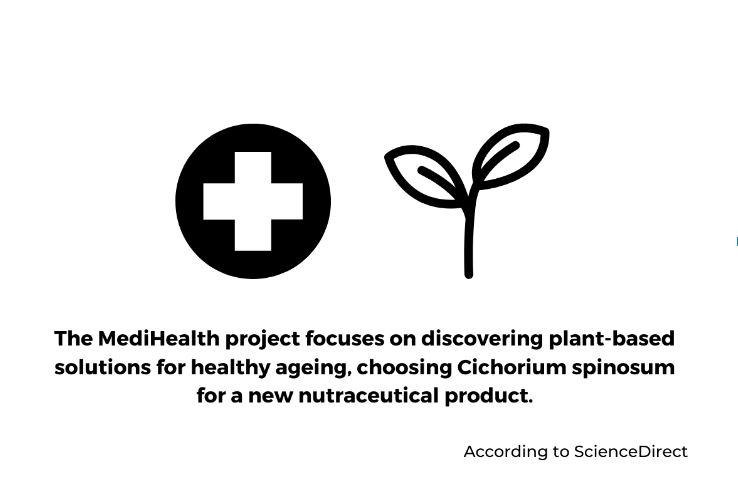Nutritional Challenges for Ageing Populations in the EU

In the European Union, the percentage of people aged 65 and above is projected to surpass the percentage of children under 15 by the year 2050, highlighting the significant impact of an ageing population on the region's demographics.
Now, let's talk about the importance of examining the nutritional challenges faced by the ageing population in the EU. This article aims to shed light on older individuals' health and lifestyle trends, the impact of nutrient shortages, the need for a balanced diet, and the latest dietary treatments used to promote healthy ageing.
The European Union consists of countries with unique food traditions and cultures. These differences contribute to varying health habits among older adults. Understanding this diversity is crucial for developing custom interventions to meet the special dietary requirements of older adults.
Key Takeaways:
Life expectancy has steadily improved in the European Union over the last few decades. However, there are disparities between member states, with some experiencing stagnation or even reductions in life expectancy.
National studies in the UK and the Netherlands indicate that many older individuals use supplements to boost their intake of vitamins D, C, and B vitamins. However, these supplements have a limited effect on their intake of iron and calcium. Supplements have been associated with improved health, especially concerning vitamins B2, B6, B12, and folate.
Micronutrient deficiencies significantly affect individuals and populations, leading to chronic metabolic disorders, reduced work capacity, lower educational achievements, and increased child mortality rates.
As the ageing European population is projected to increase significantly, promoting healthy ageing and preventing age-related diseases and disabilities becomes crucial through good nutrition, especially sufficient protein intake and physical activities.
Key Stats:
According to a Eurostat report, the life expectancy at age 65 in the EU-27 was 21.6 additional years for women and 18.1 years for men in 2018.
A report by the same source states that Italy had the highest proportion of older people consuming fresh fruit daily at 88.4%, while Bulgaria had the lowest proportion, with only 31.0% in 2017.
According to the National Library of Medicine in 2021, surveys on dietary intake have shown that older adults often do not consume micronutrients, including iron, vitamins C and D, vitamins B6 and B12, folic acid, and the trace element zinc, all of which are crucial in supporting immune function.
A 2019 Cambridge study highlights micronutrient deficiencies in older adults across Europe. Vitamin D intake falls short of the recommended 15 µg/day, with varying deficiency rates observed in Southern European countries. Riboflavin intake generally meets the recommended 1.5-2.6 mg/day, but some older adults in Lithuania and Austria may experience deficiencies. Similarly, folate intake is below the UK DoH RNI of 330 µg/day, even though most countries meet the EFSA's recommendation of 200 µg/day.
According to the National Library of Medicine report in 2022, a KORA Age Study, conducted on a population basis, found that subclinical micronutrient deficiencies were present among adults living within communities, with a significant prevalence of 52.0% for vitamin D deficiency.
A 2021 report in The American Journal of Clinical Nutrition states that older adults in Europe with lower levels of physical activity and higher vitamin B6 intake showed better performance in tests like rising from a chair and grip strength. The study suggested that vitamin B6 may play a role in maintaining physical performance, especially for those with limited physical activity levels.
Health and Lifestyle Trends Among Older People in EU Countries
Eurostat published a report targeting the ageing population of Europe. It especially focused on the health and disabilities of the ageing EU population. We will also examine the dietary trends among older people in the EU. This will help us gauge the importance of nutrition in older adults.
Life Expectancy and Healthy Life
According to the 2020 research, the European Union (EU) has witnessed steady improvements in life expectancy for both men and women over the last few decades. Life expectancy has increased by over two years per decade since the 1960s. However, some EU Member States experience stagnation or even a reduction in life expectancy.
Life Expectancy at Age 65
In 2018, women aged 65 in the EU-27 had a life expectancy of 21.6 additional years, while men could expect to live 18.1 years longer. France had the highest life expectancy at age 65, with women projected to live an additional 23.8 years and men 19.7 years. Across all EU Member States, women aged 65 generally outlived men of the same age. Lower overall life expectancy countries, like the Baltic Member States and Poland, exhibited significant gender disparities in life expectancy at age 65, with France having the fifth-biggest gap between genders.
Global Comparison
Internationally, from 2010 to 2015, men aged 65 had a life expectancy of 15.1 years, while women had a slightly higher expectancy of 17.8 years. The EU-27 displayed relatively high life expectancy compared to most G20 nations, but countries such as Japan, Australia, Canada, the United Kingdom, and South Korea outperformed the EU-27 in overall life expectancy.
Healthy Life Years at Age 65
In 2018, women aged 65 in the EU-27 could expect to live an average of 10.0 healthy years, while older men had a slightly lower expectancy of 9.8 years. Healthy life years accounted for 46.3% of women's life expectancy and 54.1% for men. EU Member States with higher life expectancy had a smaller share of senior years dealing with health issues. For example, older people in Sweden spent the vast majority of their later years in relatively good health. In contrast, those in Slovakia spent approximately one-quarter of their remaining lifespan in relatively good health.
Healthy Diets Among Older People
Individuals aged 65 or older in the EU-27 made positive dietary choices in 2017. A significant proportion consumed fresh fruits daily. They also included fresh vegetables in their daily meals:
Approximately 72.4% of older people in the EU-27 consumed fresh fruit daily.
67.1% of older individuals included fresh vegetables in their daily meals.
Variations in Diet among EU Member States
There were variations among EU Member States in the dietary habits of older adults:
Italy reported the highest proportion of older people consuming fresh fruit daily, at 88.4%.
Bulgaria had the lowest proportion of older individuals consuming fresh fruit daily, with only 31.0%.
Belgium had the highest share of older people, including fresh vegetables in their daily diet at 87.7%.
Hungary, Lithuania, Bulgaria, Romania, Latvia, and Slovakia reported less than 50% of daily vegetable consumption.
Diet differences between Older Women and Men
The EU-27 observed differences in dietary habits between older women and older men:
74.3% of older women consumed fresh fruit daily.
70.0% of older men included fresh fruit in their daily diet.
68.8% of older women ate fresh vegetables daily.
64.8% of older men included fresh vegetables in their daily meals.
Health Limitations
In 2018, approximately 72.5% of very old people aged 85 years or more in the EU-27 reported having a long-standing illness or health problem. The proportion of individuals affected by long-standing illnesses reduced as age decreased:
About 66.0% of individuals aged 75-84 years had similar conditions.
The corresponding share was lower for those aged 65-74 years, standing at 55.8%.
Prevalence of Long-Standing Illnesses by Member State and Gender
The prevalence of long-standing illnesses or health problems among very old people (aged 85 years or more) varied across EU Member States in 2018:
Cyprus reported the highest rate, with 97.2%.
Estonia followed closely with 89.7%.
Denmark had the lowest share, with 49.0%.
Belgium had a record of 45.4%, which was lower than other countries.
Gender Differences in Self-Reported Health Conditions
In 2018, a larger proportion of women (aged 65 years or more) in the EU-27 reported experiencing long-standing illnesses or health problems:
62.6% of women reported suffering from a long-standing illness group.
58.7% of men reported suffering from a long-standing illness group.
Gender Disparities Across Member States
The gender gap in self-reported suffering from long-standing illnesses or health problems was most significant in Romania, with a difference of 13.5 percentage points (58.7% among women and 45.2% among older men). Lithuania also had a double-digit gap of 10.0 percentage points.
What Are the Nutritional Challenges for the Ageing Population in EU Countries
Maintaining a diet is crucial for promoting longevity, improving quality of life and reducing the risk of illnesses and mortality. However, as individuals age, various physiological and social changes may increase the likelihood of deficiencies among the elderly.
In 2019, a comprehensive analysis published by Cambridge aimed to delve into the nutrient intake and status of adults in Europe. The study also explored whether fortified foods and nutritional supplements could help address the reported challenges faced by this age group.
The review incorporated data from surveys on diet and nutrition and large-scale studies involving individuals aged 60 years and above. These studies employed methodologies such as analysing records recalling food consumption over 24 hours and examining participants' long-term dietary habits.
The findings of this research indicated concerning trends in consumption among European individuals. Insufficient levels of micronutrients like vitamins D, B2, B12 folate and calcium were frequently observed. The review explored the benefits of consuming fortified foods or taking nutritional supplements to bridge these gaps. Encouragingly these interventions showed results in improving intake and status among older adults.
Although certain European nations displayed nutrient intake levels among their elderly citizens, others did not meet the recommended guidelines. Monitoring nutrient intake and status in light of evolving fortification practices and shifts in food consumption patterns is crucial.
The review mentioned that to address the challenges faced by ageing populations, they must maintain an adequate nutritional status. Future strategies may involve promoting food choices, improving the nutritional content of foods by reducing fat, sugar and salt and considering fortification or supplementation as effective measures to support the successful ageing of older individuals.
Significance and Intake of Micronutrient in Adults and Where EU Falls Short
Micronutrients play a role in maintaining health and preventing age-related illnesses. Keeping levels of micronutrients is particularly important for avoiding conditions like disease, cognitive decline and osteoporosis. However, as people get older, their food intake and energy requirements generally decrease, which can lead to deficiencies in micronutrients. Here are some key points highlighting the significance of micronutrients for adults:
Vitamin D is crucial for maintaining bones, muscle strength, and overall well-being. Older adults face a risk of vitamin deficiency due to skin production and less sunlight exposure. They must ensure they consume vitamin D to prevent bone-related issues. The recommended daily intake for adults is 15 µg per day. Studies indicate that the average intake in European countries falls short of this level (ranging from 2 to 8 µg/day). The prevalence of vitamin deficiency varies across countries, with rates observed in some Southern European countries possibly due to factors like skin pigmentation and sun habits. To assess vitamin D status, serum 25(OH)D concentrations were measured, revealing that several European countries have reported values below 25 nmol/l for adults.
Riboflavin (Vitamin B2) plays a role in metabolic reactions and has been associated with regulating blood pressure and cognitive decline. While older adults in Europe meet the recommended intake for riboflavin, it's still possible for deficiencies to occur. Across Europe, older adults usually consumed riboflavin in amounts that met or exceeded the recommended intake of 1.5-2.6 mg daily, with exceptions in Lithuania and Austria. Approximately 1 25% of older adults in countries did not meet the Estimated Average Requirement (EAR) for riboflavin.
Folate (Vitamin B9) deficiency can result in anaemia. Has been associated with cognitive impairment, cardiovascular disease and cancer mortality. Older adults should aim to consume 330 µg of dietary folate equivalents (DFE) daily. Generally, older adults across Europe consumed amounts of folate equivalents than the recommended intake set by EFSA (330 µg/d). While most European countries met the recommended intake for folate according to NNR (200 µg/d), their inputs were typically below the UK DoH RNI of 330 µg/d.
Vitamin B12 deficiency is prevalent among adults due to reduced absorption. Inadequate levels of B12 can contribute to age-related diseases. The recommended daily intake for vitamin B12 is 4 µg. In general, older adults across Europe consumed vitamin B12 in quantities that exceeded the Adequate Intake (AI) set by the EFSA. Serum vitamin B12 values in older adults across Europe were generally within acceptable ranges, and there was no evidence of widespread deficiency.
Vitamin C is an antioxidant that plays a role in various physiological functions. It has been linked to reducing the risk of disease and frailty among adults. Men should intake around 110 mg of vitamin C, while women should aim for 95 mg daily. In Europe, the intake levels of vitamin C among adults varied across countries, with some falling below the recommended guidelines from NNR. In some countries, it was found that about 10-35% of older adults had intakes below the Estimated Average Requirement (EAR).
Calcium is essential for maintaining bones and proper nerve transmission. It is crucial to have an intake of calcium to prevent reduced bone density and fractures. The recommended daily intake for adults is 950 mg. Among adults in European countries, there were variations in their calcium intakes compared to the PRI proposed by EFSA: however, some countries followed the recommended guidelines. When EAR values were considered, it was reported that up to 50% of adults in countries had inadequate calcium intake.
Iron is necessary for transporting oxygen throughout the body. It plays a role in various enzymatic reactions. Iron deficiency anaemia is common in older adults despite adequate intake. Mean intakes of iron among older adults in Europe generally met or exceeded the recommended intake from the UK DoH and NNR. The prevalence of iron deficiency anaemia is very low in this age group across Europe.
Iodine: Iodine is important for thyroid hormone production and overall health. An iodine deficiency can have significant health implications. The recommended intake for iodine is about 150 µg for adults per day. Mean intakes of iodine in older adults across Europe generally exceeded the Adequate Intake (AI) proposed by the EFSA. Median urinary iodine values suggested sufficient iodine nutrition in older adults in Ireland and Austria.
Magnesium: Magnesium is involved in skeletal development and muscle function. Adequate magnesium intake has been associated with reduced cardiovascular risk. The recommended intake for magnesium was about 350 mg per day for men and 300 mg per day for women. Mean intakes of magnesium in older adults in some European countries fell below the AI set by the EFSA, potentially indicating a prevalence of inadequate intakes.
The review mentioned that more research is needed to understand the patterns leading to micronutrient imbalances among adults and to evaluate effective dietary strategies for meeting nutrient needs. These strategies could involve fortifying foods (either voluntarily) or using nutritional supplements.
Many European countries recommend vitamin D supplements for adults. Studies have shown that fortified foods and supplements can improve the intake of micronutrients among adults, particularly vitamin D and B vitamins, although the effects on vitamins C, E, calcium and iron are smaller.
The Contribution of Nutritional Supplements to Older Adults' Nutrition
National studies conducted in the United Kingdom and the Netherlands have found that a significant number of individuals use supplements, which contribute significantly to their intake of vitamins such as D, C and B vitamins but have a lesser impact on their intake of iron and calcium. Various studies have also demonstrated that supplement use enhances older people's health, especially in vitamins B2, B6, B12 and folate.
The Contribution of Fortified Foods to Older Adults' Nutrition
The survey on adults as part of the DNFCS provided insights into nutrient consumption from fortified foods. It highlighted the contributions of these foods to vitamin D folate, B6 and E intake while also contributing to vitamin C, B1, B2, calcium and iron intake. Similar patterns have been reported in other European research, demonstrating the important significance of fortified foods in improving the nutritional status of older persons.
Micronutrient Deficiencies
According to a report by the National Library of Medicine in 2021, micronutrient deficiencies are quite common among adults. It can be more challenging to detect and identify compared to deficiencies in macronutrients. Surveys on dietary intake have shown that older adults often do not consume micronutrients. These include nutrients like iron, vitamins C and D, vitamins B6 and B12, folic acid, and the trace element zinc, all of which are crucial in supporting immune function. Micronutrient deficiencies can occur due to factors such as food intake, poor food choices, limited variety in diet and changes in absorption and metabolism associated with ageing.
The KORA Age Study conducted on a population basis found that subclinical micronutrient deficiencies were present among adults living within communities. Notably, vitamin D deficiency was prevalent among 52.0% of participants.
Researchers identified factors such as age, frailty, lack of activity, and irregular use of supplements as risk factors for these subclinical deficiencies. However, researchers also observed that the use of dietary supplements was associated with a reduced risk of developing subclinical deficiencies in various micronutrients.
Inflammation is quite common among adults. It can impact the levels of trace elements within the body. This can lead to iron, zinc and manganese stores, known for their protective properties against pathogens. Micronutrient deficiencies play a multifactorial role in diverse metabolic processes, immune functioning, cell proliferation, growth, signalling processes, and genomic stability. As a result, these deficiencies are implicated in the development of various conditions and age-related diseases.
It is evident that their deficiencies contribute to the development of various age-related diseases. For example, zinc deficiency has been linked to depressive disorders, loss of appetite, increased muscle catabolism, immunosenescence, and frailty.
Malnutrition
In 2019, a report on ScienceDirect discussed the risk of protein energy malnutrition in citizens. This report was part of the Joint Programming Initiative Healthy Diet for a Healthy Life MalNutrition in the ELderly (MaNuEL) Knowledge Hub. They followed the Preferred Reporting Items for Systematic Reviews and Meta-analyses (PRISMA) statement. The researchers analysed data from 196 studies, including 223 samples and 252 sub-samples obtained from various malnutrition screening tools used in settings.
The Ageing Population and the Risk of PEM
The article highlights that Europe's population, currently estimated at 515 million people, is shifting towards an ageing population. Around 19% of the population is already aged 65 years or older. This percentage is expected to rise to 29% by the year 2060. While increased longevity is an aspect of ageing, it also brings about health challenges such as protein energy malnutrition (PEM) which is common among older individuals.
Health Challenges Associated with PEM in Older Individuals
PEM has been linked to illness recovery, reduced quality of life and higher morbidity and mortality rates. The occurrence of PEM varies depending on factors like age, functional status, marital status and healthcare settings. Recent studies have reported varying prevalence rates of PEM among adults living in communities ranging from 2.5% to 16.5%.
Importance of Identifying Malnutrition Risks
Identifying malnutrition and taking action is crucial to help those at risk. It is important to have a standardised screening process that is easily accessible for use. The report emphasised the significance of identifying risks as it enables personalised support, which leads to improved clinical outcomes. A recent study in Switzerland demonstrated how tailored nutrition interventions can positively impact survival rates.
While various malnutrition screening tools have been developed, many of them are designed for populations and settings. Only a limited number of these tools have been validated specifically for adults. Obtaining estimates of malnutrition risk among adults in different healthcare and community settings is vital. This consideration is important due to the effects of systematic screening and early nutrition intervention on their well-being.
ScienceDirect is an online platform that provides access to a vast collection of authoritative, full-text scientific, technical, and health publications.
Challenges and Advances of Malnutrition in Older Adults
The National Library of Medicine recently released a report in 2021 that discussed the issue of malnutrition among adults. Although the study didn't specifically focus on the EU population, it shed light on the difficulties individuals face due to malnutrition.
According to the report hidden deficiencies, deficiencies often go unnoticed in older adults who live in communities. In some countries, malnutrition is frequently associated with acute and chronic diseases that can worsen the condition. Since older adults are more prone to developing diseases as they age, they face an increased risk of vulnerability and malnourishment.
However, it's important to note that factors contribute to adult malnutrition, including complex interactions between age-related changes and disease processes.
This comprehensive review thoroughly examined evidence regarding the prevalence and factors influencing malnutrition among adults while considering age-related changes and disease-related risk factors. The study highlighted the challenges involved in understanding, identifying and treating malnutrition. It stressed the importance of targeted supplementation of macro and micronutrients when dietary intake alone falls short of meeting requirements based on age.
Promoting ageing has become a priority for the World Health Organization (WHO) from 2016 to 2030. The goal is to empower individuals aged 65 and above to maintain their abilities and overall well-being, enabling them to participate in society. It is projected that by 2050 the number of adults will surpass the population of children under five and adolescents aged 15-24, making it crucial to address issues related to ageing.
The biology of ageing involves the decline in functions resulting in changes in how our organ systems perform and reduced resilience against physical, cognitive and mental stressors. This natural process also increases susceptibility to age-associated ailments like sarcopenia and frailty.
Ensuring nutrition is essential for promoting health and quality of life among older individuals. However, age-related changes and disease processes make them more vulnerable to problems and malnutrition.
Consequences of Malnutrition in Adults
Malnutrition can have consequences for adults leading to higher rates of illness and mortality. Disease-related malnutrition tends to cause rapid skeletal muscle wasting, while age-related malnutrition results in a progressive loss of muscle mass. These effects are closely associated with performance, an increased risk of falls and a higher vulnerability towards osteoporosis and fractures. Malnutrition also compromises immune function, delays wound healing, and increases infection risk.
The effects of malnutrition on older adults seem to be more severe than on younger adults. This can lead to syndromes that negatively impact their health, cognitive abilities, physical functionality and ability to cope with challenges. Dealing with malnutrition in adults involves the detection and implementation of multiple interventions both in hospitals and community settings. However, there are still obstacles when it comes to providing therapy.
The Role of Malnutrition in Geriatric Syndromes: Frailty, Fatigue, Sarcopenia
Malnutrition significantly impacts the health of older adults, leading to conditions such as dementia, delirium, depression, incontinence, falls, impairments in vision and hearing, difficulties with wound healing, frailty, and sarcopenia. Weight loss resulting from malnutrition can lead to a decline in skeletal muscle mass, increasing the risk of sarcopenia, which is characterised by decreased muscle mass and strength. The concept of "sarcopenia malnutrition syndrome" highlights the link between these two conditions, emphasising the importance of effective screening tools.
Another condition, sarcopenic obesity, involves decreased muscle mass and increased body fat, posing a high-risk body composition situation. Distinguishing between mass loss and overall weight loss is essential, as age-related changes can mask lean mass loss, contributing to frailty.
Involuntary weight loss is a risk factor for frailty, and malnutrition often coexists with frailty in older adults, leading to functional declines and increased mortality rates. Fatigue, an aspect of frailty, is exacerbated by severe involuntary weight loss, hindering recovery after hospitalisation. The nutritional status of individuals, including malnutrition and obesity, plays a role in managing fatigue.
Malnutrition is also associated with impairment and depression, though these relationships are complex and require further investigation. For older adults, malnutrition significantly impacts mortality rates from chronic diseases.
The definition of malnutrition is still debated, and the Global Leadership Initiative on Malnutrition (GLIM) provides criteria for diagnosing malnutrition, including weight loss, low body mass index (BMI), reduced muscle mass, decreased food intake or assimilation, and inflammation. Identifying malnutrition risk factors in older adults through screening tools is essential for early detection and prompt nutritional treatment.
The Mini Nutritional Assessment (MNA) is widely used as a screening tool, but concerns have been raised about its specificity and potential for overdiagnosis. Combining the MNA with GLIM criteria may enhance its accuracy.
Recognising and addressing malnutrition is vital in identifying and addressing sarcopenia. The GLIM criteria have shown effectiveness in predicting sarcopenia occurrence, while the MNA also demonstrates capabilities in this regard.
Macronutrient Deficiencies
Clinical malnutrition, also known as protein energy malnutrition (PEM) or protein energy undernutrition (PEU), occurs when there is an imbalance between the intake of macronutrients and the body's needs. This leads to weight loss and tissue reduction.
To prevent malnutrition and sarcopenia in adults, consuming energy (around 25-30 calories per kilogram of body weight) and higher amounts of protein (about 1.0 1.2 grams per kilogram of body weight) is important. Older adults with malnutrition or underlying medical conditions may require protein intake (around 1.2 1.5 grams per kilogram of body weight).
Prevalence of Malnutrition
The occurrence of malnutrition can differ depending on the situation, underlying illnesses and assessment methods. Studies have explored malnutrition rates in hospitals and nursing homes, uncovering rates in individuals and differences between genders, with women being more susceptible. The prevalence also varies based on the region and the approach used for evaluation.
In community settings, the risk of malnutrition ranges from 8.5% to around 30% in rehabilitation and subacute care facilities. Older adults in Southeast Asia tend to have the highest prevalence rates, while Northern Europe experienced the lowest rates. Furthermore, malnutrition is likely among those aged 80 or above, women, patients with comorbidities and individuals residing in rural areas.
Age-related changes can contribute to an increased risk of malnutrition among adults because of factors including the following.
Sensory impairment: These changes include diminished taste sensation and problems with smell perception that can reduce one's enjoyment of food and decrease intake.
Gastrointestinal changes: As people age, their digestive system undergoes changes that can affect its functioning. These changes include digestion and movement of food through the gut, which can lead to a decline in gut health.
Altered appetite regulation: Additionally, older individuals may experience alterations in the levels of hormones. Signals that regulate appetite can result in a decreased desire for food and feeling full earlier than usual. This can contribute to nutrient intake and potential malnutrition.
Anabolic resistance: Another issue related to ageing is the reduced ability of adults to use protein to build muscle mass effectively. This decline in muscle protein synthesis after meals can contribute to the loss of muscle mass, known as sarcopenia.
Inflammaging: There is a phenomenon called inflammaging, where ageing individuals experience low-grade inflammation. This has been linked to age-related diseases. It may also play a role in malnutrition among older adults. However, further research is needed to understand this connection.
Cachexia: Lastly, a condition called cachexia involves muscle wasting. The mechanisms underlying malnutrition caused by geriatric cachexia overlap to some extent.
It's crucial to consider these changes that occur with age when evaluating the likelihood of malnutrition and developing treatment plans for individuals. Understanding the complex interactions between these factors can help healthcare professionals provide better care and support for older individuals at risk of malnutrition.
Steps Required to Tackle Malnutrition in Older Adults
Understanding, identifying, and treating malnutrition in older adults still present several challenges and areas for further research. Some of the remaining challenges include:
Exploring Needs: It is important to understand the specific nutritional requirements of older adults, particularly when it comes to micronutrients and trace elements.
Effects of Ageing on Nutrition: We need to research how long-term ageing-related changes affect the development of malnutrition. Understanding the role of the ageing gut and its altered microbiome and how different dietary approaches impact it is crucial.
Combining Nutrition and Exercise: To address adult malnutrition, nutritional interventions should focus on preserving muscle mass. Be combined with exercise. Further studies are necessary to investigate the effectiveness of exercise regimens when combined with therapy.
Advancing Treatment Research: Designing clinical trials is needed to identify effective treatments for malnutrition in older adults. These trials should include outcome measures and defined target populations affected by malnutrition.
Targeting Underlying Causes: Research efforts should be directed towards developing treatment approaches specifically targeting the causes of malnutrition, known as treatment. This requires an approach and a deeper understanding of the common pathophysiology behind malnutrition causes.
Effects of Nutrient Deficiency
The National Library of Medicine released a report in 2022 concerning nutritional deficiencies. It delves into micronutrient deficiencies and how they can significantly impact individuals and entire populations. The consequences of these deficiencies are far-reaching, ranging from chronic metabolic disorders to reduced work capacity, lower educational achievements, and even diminished earning potential.
Shockingly, these deficiencies affect over 2 billion people of all ages, especially pregnant women and children under 5 years old, with about 10% of child deaths linked to them.
The report highlighted key micronutrients deficient worldwide, including iron, folate, zinc, iodine, and vitamin A. According to the report, these impairments have serious consequences, including intellectual disability, stunted development, prenatal difficulties, and higher morbidity and death rates.
Worryingly, vitamin shortages might hasten mitochondrial decay and age-related degenerative illnesses. Let us now look at the clinical signs of each deficiency:
Vitamin A deficiencies typically affect the eyes, causing problems such as xerophthalmia, Bitot spots, night blindness, and, in more extreme cases, lifelong blindness.
Vitamin B deficiencies, such as B6 and B12, cause many symptoms, including anaemia and peripheral neuropathy, dermatitis, glossitis, depression, and seizures. Those who have dietary limitations or are battling alcoholism suffer from a higher risk of these deficiencies.
Folate deficiency is linked to anaemia and can have major effects during pregnancy, such as premature birth, low birth weight, and neural tube defects. Getting enough folate throughout the periconceptional stage is critical.
Scurvy, or vitamin C deficiency, can cause bleeding gums, petechiae, ecchymoses, and poor wound healing. The deficiency can also cause behavioural and mood changes.
Vitamin D helps with calcium, magnesium, and phosphorus absorption in the digestive system. Insufficient vitamin D can lead to osteomalacia in adults and rickets in children.

Iron is vital for haemoglobin production, especially for young children and premenopausal women. Lack of iron causes microcytic hypochromic anaemia.
Magnesium is linked to colorectal cancer, osteoporosis, hypertension, metabolic syndrome, and diabetes. Deficiency can cause mitochondrial DNA damage and premature cell ageing.
Selenium is a trace mineral found in foods, soil, and water. Severe deficiency can lead to Keshan disease and Kashin-Beck disease. It also affects spermatogenesis, immune function, thyroid function, and mood.
Biotin is a rare deficiency but can occur with excessive raw egg white intake, malabsorption, or prolonged use of certain medications. This can lead to metabolic disorders and neurological symptoms.
Iodine is essential for thyroid hormone production, impacting human development and growth. Reduced iodine intake may cause hypothyroidism and goitre.
Zinc is essential for overall health, cellular metabolism, growth, immune function, and more. Deficiency signs include skin lesions, infection vulnerability, diarrhoea, poor appetite, night blindness, and impaired taste and smell.
Importance of Diet for a Healthy Old Age
The European Commission published an article on diet and healthy old age. Researchers found that the ageing population is a significant demographic trend. The 2022 article revealed that:
Over one-fifth of the EU population was 65 and over in 2021.
Experts projected that this trend would continue, with an estimated 130 million Europeans over 65 by 2050.
The article emphasised that changes in nutrition and lifestyle were the most cost-efficient ways to promote healthy ageing at the population level. Experts stated that these measures were cost-efficient due to the costly demands of the ageing population on the struggling healthcare system.
According to the article, the Mediterranean area, known for its association with low rates of coronary heart disease (CHD) and breast and colon cancer, inspired the MediHealth project.
The MediHealth project selected plants from regions (such as Greece, Vietnam, and Chile) to find plants that help individuals age better. The project eventually selected small wild green Cichorium spinosum, also known as spiny chicory, as a new nutraceutical product ingredient. Nutraceuticals are food products that provide medical or health benefits.
The initiative brought together thirteen groups of researchers from academia and the industry to examine metabolites that imitate the human digestive system's digestion of plant extracts. The scientists wanted to see if they could slow down the ageing process. They also suggested that this might provide a scientific foundation for new products that counteract the impacts of ageing.
A study cited by the article mentioned above called InDEPENDEnt focused on the impact of protein-based diets on disability in ageing Europeans and Americans. The study revealed that older people may, on average, need more protein than younger people. It mentioned that insufficient intake of protein may cause concern.
The study highlighted the importance of good nutrition, especially regarding nutrients required according to age, sex and health status.
The study also stressed the importance of physical activity in resisting age-related diseases. It stated that good nutrition and physical activity prevent muscle decline that could lead to disability. It was found that adequate protein intake is effective in preventing incident disability.
However, researchers still need to understand protein requirements under specific conditions in older adults, the differences between protein sources, and the role of amino acids. Controversies exist regarding increasing protein dietary guidelines for healthy older adults, despite broad agreement in the scientific community.
Vitamin B6 and Physical Performance in European Older Adults
A report was published in 2021 in The American Journal of Clinical Nutrition. The main aim of this research was to examine how the intake of niacin, vitamin B6, vitamin B12 and folate in the diet relates to the performance of adults in Europe who were in good health. The researchers discovered that individuals with lower levels of physical activity with a higher intake of vitamin B6 showed better performance in tests like rising from a chair and grip strength.
Interestingly, researchers observed the association between vitamin B6 and grip strength, specifically among participants with a lower level of activity. These participants scored below the recommended level on the PASE scale, which measures physical activity, suggesting that physical activity might play a role in this association. Vitamin B6 plays a role in breaking down glycogen and metabolising amino acid processes that exercise can influence, which could explain this interaction effect.
On the other hand, regarding chair rise test performance, there seemed to be no variation based on activity levels when considering vitamin B6. This difference might be because the chair rise test primarily measures muscle power while grip strength reflects muscle strength – indicating mechanisms.
Previous studies have also reported a connection between vitamin B6 intake and physical performance. One research study discovered a correlation between increased consumption of vitamin B6 and a reduced risk of mobility among adults in Spain. Another group survey found that lower intakes of vitamin B6 and folate were associated with an increased likelihood of developing frailty.
When individuals consumed vitamin B6, vitamin B 12 and folate together, it was linked to levels of homocysteine which can contribute to maintaining performance. Vitamin B6 plays a role in metabolic pathways related to fatty and amino acids crucial for optimal physical function.
It's important to note that this study has limitations since cross-sectional means causality cannot be determined. Additionally, the high level of performance observed in this group with minimal variation between individuals may limit how applicable these findings are to other populations.
In summary, this study suggests that increasing the intake of vitamin B6 may have implications for maintaining performance in adults, particularly those who engage in low levels of physical activity. However, more research is necessary to establish a relationship and examine the effects on vulnerable populations. Overall incorporating vitamin B6 into one's diet may prevent age-related decline in performance when increasing physical activity isn't feasible.
FAQs
How does the ageing population affect the UK?
According to The Health Foundation, in 2021, the population of England is undergoing an ageing trend. Over the coming 25 years, the count of individuals aged 85 and above was anticipated to rise twofold, reaching 2.6 million.
Which country has the highest ageing population in Europe?
According to Statista, in 2022, Italy held the highest proportion of the elderly population among European countries, with 23.8% of its total population being 65 years or older.
What is the problem with the Ageing population in Italy?
According to CGTNin 2023, The presence of ageing populations can lead to an economic imbalance, as a larger number of elderly individuals claim pensions and other state benefits. Simultaneously, there may not be enough younger people in the workforce to generate sufficient tax revenue to fund these benefits adequately. This demographic challenge poses significant considerations for policymakers in managing the nation's social welfare and economic stability.
Conclusion
Reports stress the crucial role of diet and nutrition for the ageing population in EU countries. Policymakers and healthcare professionals must address nutritional challenges as the proportion of older adults increases. It is evident that advancement in healthcare improves life expectancy. The differences in life expectancy among EU Member States highlight the need for targeted interventions to address health inequalities.
Promoting positive eating habits among adults is essential, as observed consumption of fruits and vegetables indicates a strong inclination toward maintaining good health in older populations. Addressing health issues in older individuals is crucial, emphasising tailored healthcare support. Early detection of malnutrition risks can improve outcomes for seniors. It can reduce the impact of protein energy malnutrition and promote healthy ageing. Adequate intake of micronutrients is vital in preventing adverse health outcomes in older adults.
The ageing population in EU countries requires evidence-based strategies to promote healthy ageing. These strategies include improved food choices through fortification and supplementation. Research on protein requirements and amino acids will lead to better dietary guidelines. It is important to invest in understanding the nutritional needs of older individuals. Through this, the EU can create an inclusive and thriving environment for its ageing population. Prioritising nutrition and physical activity can significantly impact healthy ageing.
Thus, targeted efforts in nutrition and healthcare will contribute to a healthier and more fulfilling ageing experience. These benefit older adults' well-being. However, they also enhance society's overall sustainability and inclusiveness as the proportion of older adults continues to rise.










![[SV24] Soy Protein Powder](/web/image/product.product/1033/image_256)